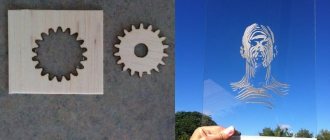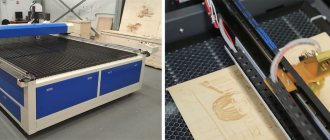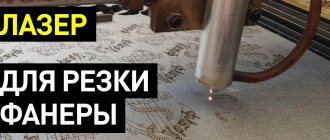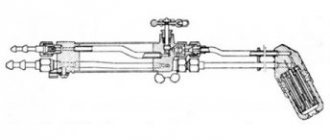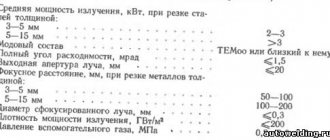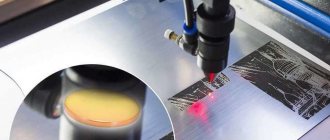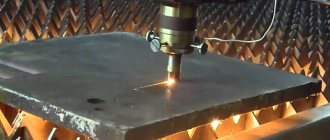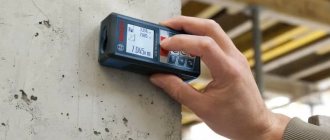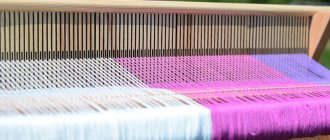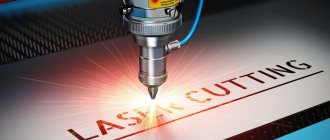Laser CNC machines are used to produce furniture, promotional items and souvenirs from wood or plastic. The engraver's range of actions includes cutting, burning, and engraving. The workflow is quick and easy. Laser can be used to apply pictures, emblems and logos to wooden and plastic surfaces.
An engraving machine can be purchased at a store or assembled with your own hands. Making a laser for cutting plywood yourself is not that difficult. A homemade device will have lower power and, nevertheless, you can create full-fledged engravings on it.
Laser machine control board: M2 Nano, RuiDa
So, well, let's start then! Let's start with the front panel!
This model has a RuiDa control system, not an M2. RuiDa is a cooler board. The main advantages of the RuiDa board:
- Ability to change laser power without human assistance. Thanks to this, you can engrave photographs. On the M2 you can only do single color engraving in one pass.
- Continuation of operation from the moment of emergency stop. For example, if the electricity goes out, after turning it back on, the machine will continue to work as if nothing had happened.
- Ability to work without a computer, reading a file from a flash drive.
- Possibility of connecting the machine to a local network.
- Availability of a Russian interface (for many users this is important).
- Possibility of embedding LaserWork into graphic editors CorelDraw, Adobe Illustrator, Autocad, Inscape.
- Backlash compensation.
- Self-diagnosis.
- Supports multi-positioning (you can set several reference points to start working).
- Ability to view layers
- Calculation of the exact processing time of the material
You can change the board from M2 to RuiDa at any time, you will have to tinker for a day, though.
The top photo shows just the front panel, but the brains of the machine look different. Here they are:
M2 Nano control board
To make it clear: this board consists of:
- USB UART converter - transmits and converts commands received from the computer to the microcontroller
- Microcontroller - converts commands directly into the movement of the laser head itself and turning the laser on/off. He does this with the help of stepper drivers.
- Two stepper motor drivers - control the current of stepper motors.
- Harness
RuiDa control board
RuiDa's structure is much more complex. Here it is disassembled.
There is already a fast 32-bit TMS320 microcontroller, Altera FPGA and memory modules. This is what I saw right away; I didn’t look for the rest on the Internet. The point is clear. The capabilities of this board are much higher - it is an independent computer. However, RuiDa does not have stepper motor drivers on board - they will have to be purchased separately.
Materials for processing
Using laser machines with numerical control, you can process the following materials: acrylic, polyester, two-layer plastic, plywood, veneer, wood, cardboard and paper, leather, stone, glass, mirror, etc.
And with the help of non-contact technology, it is also possible to process fairly thin materials (paper, leather, etc.) - these are materials that until recently were quite difficult to automate.
Stepper motor drivers for laser machines
Don’t rush to buy the most expensive drivers right away. Drivers have three main parameters: current, the minimum period length for the STEP clock signal, and the maximum microstep. If you have questions, it’s better to ask ON THE FORUM
We even made a special expansion board for the small laser machines of the HOBBY and OPTIMA series.
Using this board, we can install more powerful drivers instead of standard drivers, or vice versa, drivers that will make the engines operate absolutely silently. This idea came to my mind after I was assembling another machine and I needed drivers, but everything was out of stock. I bought expensive stepper motors in a St. Petersburg store and installed them on the machine - everything seemed to work, I drove it at high speeds and that was it - skipping steps right away. I thought for a long time what the problem was until I figured out how to figure it out. It turns out that instead of a branded mikruhi, there was some kind of Chinese remake. We had to remove the drivers from our office machine so that the person would not delay the delivery, however, now the person has super powerful 5 Ampere drivers, although in reality they need 0.5 Ampere and 1 Ampere. We sign all the machines, because people get the hang of it much faster this way. The drivers on this machine are installed on the right.
Well, in the meantime I made the following temporary solution for our standard machine:
I took the drivers from our 3D printers and configured Ruida for them, soldered everything together, and until the arrival of new drivers, everything will remain in this state. The main thing is that everything works at high speeds. Engraving at a speed of 500 mm/s without problems.
In general, the task of stepper motor drivers is to provide the correct current to the windings and not slow down when receiving control signals from the microcontroller, so that the motors quickly and accurately ensure the movement of the laser nozzle over the working field.
DIY machine
It is not so difficult to create a CNC laser machine with your own hands; for this you will need to stock up on the appropriate material. The device will differ from industrial machines in power. A homemade laser machine will have a power of about 2 W, while industrial machines use lasers with a power of 50 W. Using such equipment it will be possible to process cardboard, wood, and plywood.
To assemble the engraver yourself, you need to purchase a programmable board. They are presented in a wide range in the store; any mechanism can be assembled on their basis. Homemade machines differ from factory machines, but a machine of this type can be used to carry out a wide range of work. Do not forget that lasers must be cooled; for this purpose, a special cooling system is created using a pump and liquid.
Laser tube ignition unit
You can return to the previous drawing - this block is signed. Quite a massive black box. Another important element of a laser machine. In order for the tube to work, this unit raises the voltage at its terminals to a voltage of more than 20 kV and raises it until a discharge begins in the tube. If the tube fails and the discharge never begins, the high-voltage unit will either turn off or continue to produce the highest possible voltage, which can damage it.
Let's assume that the tube is working properly and the discharge has begun - now the high-voltage unit turns on the current stabilizer to maintain the required current, regardless of the load in the circuit. The voltage usually decreases.
Advantages and disadvantages of laser cutting
The undoubted advantages are the following:
- Laser cutting is capable of processing a variety of materials;
- The absence of direct mechanical contact virtually eliminates the risk of damage to the surface being treated;
- The machine can perform work of any degree of complexity, while obtaining perfectly even cuts and lines is guaranteed;
- The work performed is characterized by high productivity and speed;
- The process itself is carried out silently, there is no large amount of dust and debris.
The disadvantages of working with a laser include:
- The stamping method of processing workpieces is much cheaper than the laser method;
- When processing wooden surfaces, dark traces remain at the points of contact with the laser spot;
- The laser machines themselves (especially industrial designs) are very expensive;
- There are restrictions on the thickness of the working surface of materials.
The range of products that can be produced on a laser machine is very wide; the unit is perfect for manufacturing:
- Various stencils and plywood blanks;
- Metal constructors and their individual elements;
- Seals and stamps;
- Street signs and road signs;
- Designer cards;
- Engraved souvenir items;
- Decorative elements containing carved patterns;
- Decorations and screens;
- Layouts for architectural projects and much more.
Laser tube
Oh, this is the most interesting place. For many, something strange and incomprehensible begins here. Let's start simple: what is a laser tube?
Let's start with the simplest definition. The laser tube is a glass bulb that has 3 internal cavities. Water or other coolant flows through the middle of the cavities. But in the other two cavities there is a mixture of gases. What kind of mixture of gases is this?
It consists of:
- CO2 (carbon dioxide) is a gas that releases energy in the form of photons. Together they produce laser radiation.
- N2 (Nitrogen) is a good resonator. It converts most of the absorbed energy into vibrations, causing CO2 particles to collide with each other.
- He (Helium) - it increases the rate of photon emission. But Helium also has high thermal conductivity, which helps keep CO2 at a low temperature. And the low temperature of CO2 allows you to create a high population of low energy levels. This allows CO2 to emit more new photons. Well, the low temperature of CO2 slows down the rate of its degradation. But Helium atoms are very small and they even leak through the glass from which the laser tube is made. Therefore, an old tube (more than 2 years old), which has never even been used, will have a low radiation power, and will also very quickly become unusable due to CO2 degradation.
A photon is emitted in the following cases:
- A charged CO2 particle collides with a photon or neutral atom.
- Collision of N2 atoms with CO2 atoms
- Exposure to external electromagnetic field
In order to create positive feedback, the tube has an optical resonator.
Laser tube structure
The resonator consists of a glass bulb (marked in red) and two mirrors. One has a reflectance of 100% (in practice 98%), the other has 50%.
Interference of waves occurs in an optical resonator. The wave traveling near the resonator axis is amplified and reflected from the mirrors. Moreover, with each such reflection, the wave only partially passes through the mirror with a reflection coefficient of 50%. Actually, the first 50% is supplied directly for cutting the material, and the second half is reflected and remains in the resonator.
The higher the temperature of the laser tube, the paler the violet discharge becomes.
Rating of the best laser cutting machines for 2022
Budget models
2nd place: WATTSAN MICRO 0203
An excellent example of a home machine, intended exclusively for decorative and applied purposes. With its help, it is easy to cut out patterned parts from thin-sheet plywood or make ornaments on plexiglass. Due to its extremely small dimensions, its installation does not even require a separate room.
| Name | Index |
| Manufacturer country | Great Britain |
| Beam power, W | 40 |
| Power supply, V | 220 |
| Weight, kg | 28 |
| Cost, rubles | 55000 |
WATTSAN MICRO 0203
Advantages:
- Small dimensions;
- Economical cost;
- Sufficient thickness of the processed material (5-12 mm).
Flaws:
- Narrow application area.
1st place: ZERDER FLEX 1060
A model from a fairly young, but already becoming popular German company. It has quite large dimensions and has a relatively high positioning accuracy of the laser beam. Thanks to the increased working surface, it can work with large workpieces.
| Name | Index |
| Manufacturer country | Germany |
| Beam power, W | 80 |
| Power supply, V | 220 |
| Weight, kg | 77 |
| Cost, rubles | 120000 |
ZERDER FLEX 1060
Advantages:
- Large work desk;
- Low price;
- The laser tube is rated for 6000 hours.
Flaws:
- Low power laser.
Middle class samples
2nd place: MCLASER 4030 METAL
A universal machine capable of working with both metals and thinner materials. With a very powerful laser, it can also be used in domestic conditions, due to its relatively small dimensions and weight (it can be installed in a home workshop). However, the desktop area is small - 40 by 30 centimeters.
| Name | Index |
| Manufacturer country | China |
| Beam power, W | 120 |
| Power supply, V | 220 |
| Weight, kg | 80 |
| Cost, rubles | 405000 |
MCLASER 4030 METAL
Advantages:
- Excellent quality of components (despite their Asian origin);
- Universal model;
- Ability to cut metal up to 2 mm thick.
Flaws:
- Small desk.
1st place: RABBIT FB 2030
A wide-format unit positioned on the market as a professional model. It has a high cutting speed, the working table area is 2 by 3 meters. The design includes two powerful lasers and a system of gold-plated mirrors. Perfect for a highly specialized workshop. The service life of the laser tube is extended to 6500 hours.
| Name | Index |
| Manufacturer country | China |
| Beam power, W | 200 |
| Power supply, V | 220 |
| Weight, kg | 450 |
| Cost, rubles | 1000000 |
RABBIT FB 2030
Advantages:
- Multifunctionality;
- Increased working surface;
- The permissible thickness for fragile materials is 28 millimeters!
Flaws:
- Large dimensions;
- High price.
Models from the premium segment
2nd place: MCLASER 1530 750W METAL
A very powerful machine designed specifically for working on thick metal alloys. Capable of cutting workpieces up to 10 millimeters thick. The working surface is quite large - 1.5 by 3 meters. It features increased productivity and speed.
| Name | Index |
| Manufacturer country | China |
| Beam power, W | 800 |
| Power supply, V | 220 |
| Weight, kg | 750 |
| Cost, rubles | 4000000 |
MCLASER 1530 750W METAL
Advantages:
- The operating life of the beam tube has been extended to 10,000 hours;
- The kit includes a separate operator panel;
- Power increased.
Flaws:
- Large weight and dimensions;
- Very high price.
1st place: Fiber FB1325
This laser machine is designed with a high-power fiber optic generator, Western European linear guides, and a high-precision CNC system. The device is capable of working on thick metals and their alloys. In general, it is characterized by high cutting efficiency and economy.
| Name | Index |
| Manufacturer country | China |
| Beam power, W | 950 |
| Power supply, V | 220 |
| Weight, kg | 800 |
| Cost, rubles | 4700000 |
Fiber FB1325
Advantages:
- Fully professional model;
- Versatile and multifunctional;
- Uses economical cutting technology.
Flaws:
- Not detected (for its segment).
Laser machine mirror system
I hope you now have a better understanding of how the laser tube works. Let's return to the half of the radiation that is released by a mirror with 50% reflection. This radiation will cut the material. But first you need to direct it correctly. The quality of the cut greatly depends on the correct setting of the mirrors.
As soon as the radiation leaves the tube, it hits the surface of the mirror for the X axis. This mirror is motionless, the adjustment must begin with it. The main task is to make sure that the beam reflected from this mirror hits the same point on the mirror along the Y axis. It doesn’t have to hit the center, the main thing is that it hits the same point.
After the X-axis mirror is adjusted, you need to adjust the Y-axis mirror in exactly the same way. The last mirror is the lens mirror. Its task is to correctly apply the beam to the lens, so that the lens will correctly and accurately focus the radiation, and you will get a high-quality cut.
Some people who bought a machine somewhere else have a problem. Even if all the mirrors are clearly adjusted, the beam does not hit the same point in different places. The answer to this problem is almost clear - the fault lies in the mechanics and the machine guides are not parallel.
Main significant parameters when choosing a laser device
Modern manufacturers are constantly and actively working to modernize and reduce the cost of existing technologies, so the market is constantly replenished with new models. Based on the required tasks, when choosing a unit you should pay close attention to the following factors:
- Production volumes - home single use or there is a need on an industrial scale;
- Dimensions of the machine - it all depends on the size of the available premises;
- The main type of future materials is that fiber optic lasers are suitable for metal and plastic, while carbon dioxide models are usually used for fabric and paper, rubber and wood;
- Emitter characteristics - power will indicate operating speed;
- Possibility of moving the work table - the thickness of the workpieces being processed will depend on this parameter;
- Number of cutting heads – having more than one head means increased productivity. An engraving machine requires at least two of them;
- Equipped with a video camera - with its help it is easiest to transfer the required image to the operating program of the device;
- Roll feed mechanism - they will need equipment if they plan to work with materials that can be rolled into a roll (paper, fabric, etc.);
- Additional accessories - this may include an additional table surface, an external cooling device, a rotating device, the ability to replace the laser tube with an element of higher power, etc.
Lens focusing, table lifting mechanism
Adjusting the lens focus can be done in three ways:
- Manual focusing: installed on the most budget models, you adjust the height of the lens yourself. An absolutely normal manual method, due to the absence of additional mechanical parts, such machines are very small.
- Focusing using a lift table. Here the table is already connected to screw rods, which are driven by a motor.
Screw rods, motor and honeycomb table
- Focusing using lift table + autofocus. The same as the second one, but there is a limit switch or distance sensor near the nozzle. Thanks to this device, you simply place a sheet of material on the table, and the machine itself will adjust the focus. True, there are also funny cases. Sometimes limit switches are installed in the form of a thin button. People can also be inattentive and tired. And if the nozzle is not above the sheet material and you turn on autofocus, then there is a very high probability that the button will fall between the table honeycombs or slats, the machine will not notice the obstacle and will continue to raise the table. I won’t show you how it all ends here). Conclusion: make sure the end cap is thick enough, be more careful or focus manually, it takes no more than a minute.
- Add. option - RED LIGHT focusing. To be honest, I never use it, maybe in vain, but somehow it’s easier for me to make a measuring figure and focus on it.
Frame
The housing affects the dimensions of the material being processed, the correct cutting and engraving geometry, maintaining the geometry during transportation and operation, affects the protection of key components, such as control electronics from material combustion products, the ability to install options such as a lifting table or conveyor, the ability to feed long materials through work table top.
When choosing manufacturers for the range of laser engravers, we took into account all the necessary wishes in the lines of manufacturers Alfa-J and JQ, the latter has more than 10 years of operating experience in the Russian Federation, including in harsh conditions of stone engraving, and Alfa-J has similar characteristics without overpaying for brand.
For example, all the edges of the steel sheets when assembling the body have an end bend, which adds lateral rigidity compared to competitors:
The control panel is enclosed in a separate casing to protect it from combustion products:
Hinged housing covers allow processing of long materials:
Thus, the body of Alfa-J machines is suitable for specialization for any task, has a large margin of safety, thoughtful details, such as pneumatic struts for lids, limit sensors for closing lids, and on their basis you can build any cutting or engraving machine.
Laser tube cooling
Here I would make a division into three types:
- The CW3000 chiller is a rather useless option. The essence of his work is as follows. The CW3000 is a tank of approximately 9 liters with a radiator, pump and fan. All. As you understand, the tube quickly warms up 9 liters and the radiator and fan cannot cope with cooling, since the machines are installed in heated rooms.
- Pump - despite the fact that this option is cheaper, it turns out to be more effective. The main thing is to use a large container - from 35 liters. With such a capacity, the tube does not have time to heat the water. The main thing is that the room is not too hot. As a rule, in most industrial Temperatures in rooms and houses around 22 degrees are within normal limits.
But sometimes people buy a machine for their home, but there is only a place next to the battery. This is a very bad option, but in this case you can freeze bottles of salt water in the freezer and put them in a container while cutting. - Chillers CW5000, CW5200 are not a cheap option; such chillers are simply necessary for powerful pipes. Their advantage is that even in hot weather you can work on the machine without any fears about the pipe, since such chillers work on the principle of a refrigerator.
Technical characteristics of the main types of laser systems
Depending on the material being processed, they can be divided into:
- Solid-state lasers of the pulse-periodic type with lamp pumping (output power: 50 – 1000 Watts) are used for cutting thick metals;
- DPSS diode-pumped solid-state lasers are used for medium-thick metals;
- Continuous gas infrared CO2 lasers (output power up to 400 Watt) are used to work with non-metallic workpieces (rubber and polymers, as well as wood);
- Continuous gas CO2 lasers (output power - from 0.7 to 6 Kilowatts) are suitable for working with alloy steel, ferrous metals, some types of metal alloys, as well as for non-metallic materials;
- Fiber optic lasers (output power from 0.4 to 15 Kilowatts) – for spot cutting.
At the moment, the use of laser equipment cannot completely displace classical metal cutting methods from the market. Therefore, their effective use becomes possible only when the material being processed is selected correctly, based on the capabilities of the equipment, and when using the traditional method becomes labor-intensive or completely impossible.
Lenses, mirrors, optical accessories
Alfa-J laser engravers use the latest generation of mirror holders, a protective casing protects from dust and combustion products, and makes it easy to find the center of the mirror when adjusting:
We have never seen such an implementation on any competitive machine. Also pay attention to the system for adjusting the position of the mirrors; there is an adjustment for both the offset at the base of the holder and three-point adjustment of the mirror tilt with locking locknuts; such a system will allow you to accurately adjust and securely fix the adjustment position for the entire period of operation.
You can choose from solid molybdenum mirrors; such mirrors can be polished on a tool maker’s polishing table if they become cloudy; you can also install silicon ones with copper plating - such mirrors cannot be polished, but are also cheaper.
The diameter of mirrors and lenses is important when specializing a machine for engraving or cutting. Thus, large-diameter mirrors and lenses reflect and transmit a laser beam with minimal power losses, which is good for cutting, but in engraving, the characteristic of the size of the light spot becomes more important, and the smaller the diameter of the laser beam at the entrance to the lens, the more compact the light spot will be. material. And since any beam, even a laser one, has the property of scattering as the beam of a flashlight becomes wider as it moves away, for engraving it is better to use optics with smaller diameters in order to minimize the diameter of the beam when transporting from the emitter to the lens in the head, therefore engravers use mirrors with a diameter of no more 20mm, and lenses with a diameter of no more than 15mm.
The lens material is also responsible for the compactness of the light spot on the material, so gallium arsenide (GaAs) has a higher refractive index and is more preferable for engraving, and zinc selenide (ZnSe) lenses have a lower refractive index and are preferable for cutting.
For comparison, a photo of bad fittings, fastening on a thin bending corner, fixing with a lock nut - throws off the set settings, savings even on the spring clamp - made from a hairpin:
Lens
An important point in machine tool building: the sum of the components of a laser machine does not always guarantee a good result.
Let's take the example of a car manufacturer. If we replace some elements on a Lada: engine, wheels, gearbox, then we still won’t get a BMW. In order to create something complex and of high quality, you need competence.
Some Russian manufacturers make their own optics and calculate optical channels. For what?
In the movement system, the final unit is the lens; it consists of several glasses. Each glass is a source of reflection, i.e., light passing through the glass is reflected back to a small percentage (the better the glass is made, the less).
The lens has some curvature, and when reflected, the light can be focused. If the situation is unsuccessful, a reverse glare appears, which will focus on the mirror.
Example of damaged mirrors
Example of damaged mirrors
Photo of the scanning head lens with cloudiness
The distance between the lens and the mirror should focus either before or after the mirror. If you screw in a lens that does not fit a given optical path and expect everything to work perfectly, there is a huge risk of getting into an unpleasant situation where some expensive element is damaged.
Guarantee
By law, the manufacturer is required to provide a warranty for laser equipment for at least 1 year.
Most often, a Chinese manufacturer that sold laser equipment with a cost of, for example, 600,000 rubles, can safely give you a guarantee for a longer period (but with problems). After all, the cost of the equipment will be, conditionally, 300,000 rubles, the repairs will cost you another 100,000 rubles, and the rest will go to the company’s profit (and in a year you will already forget what kind of guarantee you have).
Why are there problems with the warranty?
Companies selling Chinese lasers have a high workload. Having sold a certain number of machines, they constantly repair and maintain their equipment. From a business point of view, this is good, especially when the warranty expires, you can profit from the grief of customers. But, from the consumer's point of view, the standard story turns out - the stingy pays twice.
